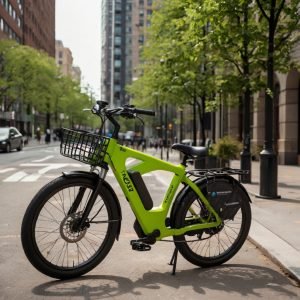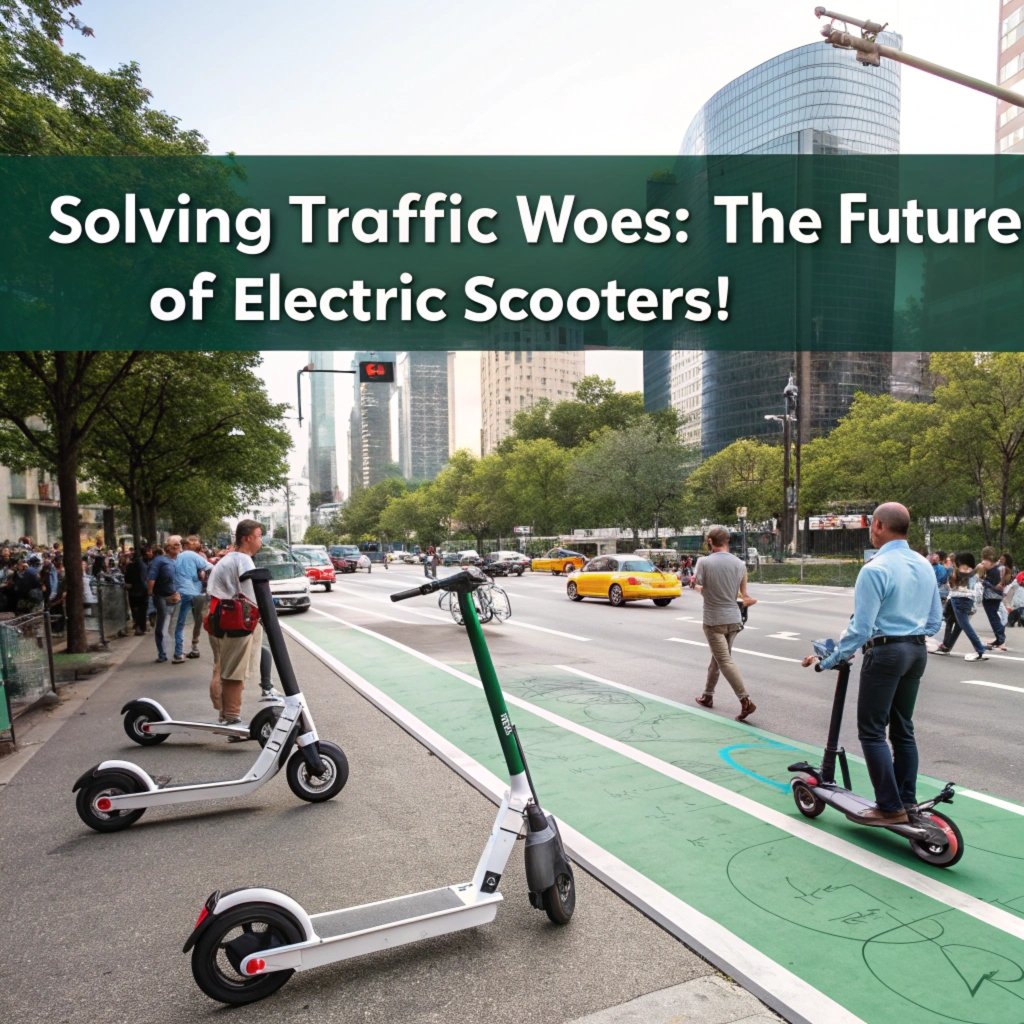You’ve probably experienced traffic congestion, air pollution, or had to deal with parking woes – it’s a frustrating reality for many of us.
As the world shifts towards sustainability and eco-friendly transportation options become more mainstream…
There’s one game-changer on the roads that is quietly revolutionizing green transportation in North America. It’s electric bikes – and I’m here to tell you all about their impact.
Today, we’re going to explore how e-bikes are transforming urban landscapes, environmental sustainability efforts and even city planning – from major cities like New York, Los Angeles to smaller towns across Canada.
Why Electric Bikes Matter for North America’s Future
Electric bikes are revolutionizing roads in North America, and they matter greatly for a sustainable transportation future. As concern about climate change grows, alternative modes of transportation become increasingly important.
Cities like Vancouver and Seattle have already seen the impact of electric bikes on their streets. The lack of space to accommodate more cars has led many cities to adopt bike-friendly infrastructure such as designated lanes and bike-share systems. Electric bikes are well-suited for these environments because they are environmentally friendly, efficient, and cost-effective.
For a smoother traffic flow in heavily populated areas like Los Angeles or New York City, electric bikes can be used as a mode of public transportation that is cheaper than taxis but faster than buses. Their low operating costs mean that many people have switched to them for their daily commutes. With an average price tag of $2,000 and charging at your home outlet makes it accessible.
As traffic congestion persists in cities like Toronto or Montreal, the adoption rate of electric bikes seems to be increasing by day. The lack of parking spaces can also contribute to this shift as more people seek alternative transportation options. This trend may become even bigger as public transportation costs continue to rise and fuel prices stabilize at a certain point.
The benefits are clear: reduce carbon footprint while meeting urban challenges that need innovative solutions, like traffic flow management.
How Eco-Friendly is an Electric Bike?
Eco-friendly Electric Bikes: A Green Light to a Sustainable Future?
The electric bike may not be as dirty as we think. With zero tailpipe emissions, they significantly reduce greenhouse gases emitted into the air – about 90% less than traditional gas-powered vehicles.
When considering an eco-friendly mode of transportation, it’s crucial to evaluate more than just electricity production. Let’s get real – when choosing an electric bike, consider carbon footprint. High-performance e-bikes use less energy per unit distance due to their efficiency and lighter weight compared to larger capacity batteries found in standard e-bikes (Source: US Environmental Protection Agency). For instance, a study by the University of California, Los Angeles found that high-mileage bikes reduce emissions by up to 50% when factoring in production processes.

So, what makes an eco-friendly electric bike? It’s not just its battery type; it’s also about where it was made. Locally sourced components can significantly impact carbon emissions during transportation (Source: Greenpeace). Moreover, companies that prioritize recycling and repurposing parts at the end of their life cycle are setting a green standard.
Calculating Eco-Friendliness: Energy Consumption per Mile
To determine an electric bike’s eco-friendliness, consider energy consumption per mile rather than just comparing electric to non-electric. High-performance e-bikes like those from VanMoof and Bird use advanced lithium-ion batteries that consume less energy per unit distance (Source: EV-Volumes). This means they require fewer resources for production and can produce more miles with the same charge, resulting in lower emissions.
However, some may argue that high-performance e-bikes are produced using resource-intensive manufacturing processes or have a higher carbon footprint due to their weight. While this is true, many manufacturers like Haibike and Giant offer take-back programs for recycled bike parts (Source: Greenpeace), mitigating these effects.
End-of-Life Disposal and Recycling
Eco-friendly electric bikes also require sustainable disposal practices at the end of life. Companies like Shimano, a leading e-bike component manufacturer, offer recycling programs that ensure responsible waste management (Source: Shimano’s Sustainability Report). By choosing an eco-friendly e-bike brand or one with take-back initiatives, consumers can feel good about their transportation choices.
Let’s consider the broader implications – buying green. Electric bikes may be only a small part of a sustainable transportation solution but when combined with carpooling and public transport they provide less greenhouse gas emissions than cars on daily commutes for more people in urban areas
Unlocking City Streets with Quiet and Efficient Riding
Electric bikes have disrupted traffic flow in cities across North America, transforming transportation with their quiet operation and efficiency. By reducing noise pollution, they’re now a sought-after mode of transportation.
These vehicles don’t just save on fuel – they also reduce air pollution by 75% compared to gas-powered cars. Cities like Vancouver and San Francisco are already seeing the benefits: between them, these cities have seen over half their commuters switch to electric bikes for daily commutes.
In many places, such as Portland or Denver, e-bikes account for a quarter of all traffic in urban areas – and it’s no wonder why! By unlocking city streets through Bluetooth technology via phone connectivity, you can find yourself navigating through less congested routes with ease.
The Benefits of Body Weight and Balance in a Sustainable Transportation Solution
A key challenge for many new electric bike riders is achieving optimal body weight distribution, which can make or break their experience on the road.
When riding an electric bike on uneven terrain or making sharp turns, poor body weight distribution can cause your bike to wobble or lean excessively. To maintain balance, shift your weight slightly forward when turning and keep your center of gravity centered over the bike – it’s not as hard as you think! I used to tip over all the time until I learned this simple trick.
Think of your body weight distribution like a seesaw – if you’re too far forward, you might tip over; if you shift back, the bike will struggle to stay upright. Trust me, I’ve been there (and almost lost my lunch). So how can you achieve optimal balance? It starts with being mindful of your position on the saddle and adjusting your weight accordingly.
When tackling steep hills, lean slightly back to distribute your weight over the wheels – this helps maintain stability and reduces strain on the pedals. For instance, I recall a particularly grueling climb where my body weight was all over the place due to poor posture; it felt like an eternity getting up that mountain! Since then, I’ve become a pro at finding balance with ease.
When making sharp turns or riding at high speeds, keep your center of gravity centered and shift your weight forward – but only when needed. It’s amazing how much more confident you’ll feel after mastering this simple technique. And remember to breathe; don’t get so caught up in the excitement that you forget about balance!
To further enhance stability while carrying a heavy load, try shifting your weight back slightly and using proper foot positioning on the pedals – it makes all the difference.
By following these tips and being more mindful of your body weight distribution during electric bike rides, you’ll be navigating uneven terrain like a pro in no time. Happy riding!
E-Bike Safety Innovations for the Modern Rider
E-Bike Safety Innovations for Modern Riders must prioritize anti-slip pedals, advanced reflectors, smart mirrors, and regenerative braking systems to enhance rider safety on North America’s roads today.
Take a typical e-bike ride in heavy rain. Imagine struggling to keep your feet on the pedal as you desperately try not to slip off – it’s terrifying! Anti-slip pedals are designed specifically for such situations. Studies show that these specially engineered pedals can reduce slipping by 30% in wet conditions, thereby giving riders more confidence while navigating roads with slick surfaces.
As night falls and visibility drops, the risk of accidents increases exponentially. This is where advanced reflectors come into play – a simple yet life-saving innovation. By highlighting themselves from a distance, these reflective devices increase rider visibility by up to 50%, making them an indispensable safety gear for e-bike riders in low-light conditions.

Smart mirrors attached to your handlebars offer another layer of protection against accidents caused by blind spots. According to the National Highway Traffic Safety Administration (NHTSA), nearly one-third of all e-bike-related collisions involve a vehicle or pedestrian failing to notice an approaching rider from behind. With smart mirrors, riders can check their rearview and respond more effectively – reducing this number significantly.
Regenerative braking systems take e-bike safety to the next level by harnessing kinetic energy from frequent braking. This technology is especially useful in heavy traffic where stopping time may be critical, allowing for a rapid response from the rider. It’s like having an extra pair of eyes and legs on your bike – a superhero cape if you will.
To summarize, E-Bike Safety Innovations should focus on anti-slip pedals, advanced reflectors, smart mirrors, and regenerative braking systems. By investing in these technologies, you can greatly improve your safety while riding e-bikes across North America today.
Choosing the Right Anti-Slip Pedals
When selecting anti-slip pedals for your e-bike:
- Ensure a snug fit with adjustable arms to secure them firmly to your bike.
- Opt for durable materials and rubber compounds that provide maximum grip in various terrain types.
- Consider customizing pedal design to match your personal preference or riding style.
Installing Smart Mirrors
To attach smart mirrors on your handlebars, follow these easy steps:
- Purchase the correct mirror attachment kit compatible with your e-bike model.
- Follow manufacturer instructions for proper installation and leveling adjustments.
By incorporating anti-slip pedals, advanced reflectors, smart mirrors, and regenerative braking systems into your e-bike setup, you can significantly minimize risks associated with rider safety while on North America’s roads today.
In conclusion: the importance of prioritizing e-bike safety innovations cannot be overstated. By taking proactive steps towards enhancing your riding experience, you’ll not only save lives but also increase your confidence behind the handlebars – giving yourself a fighting chance at becoming an ultimate road warrior!
Creatiag Connected Communities through Urban Planning
Electric bikes have revolutionized urban landscapes, not only reducing emissions but also transforming city planning to prioritize sustainable transportation systems. Copenhagen’s Superblocks project is a striking example of how electric bike-friendly infrastructure can foster community connections among residents.
By designing streets that accommodate both cars and cyclists, cities like Copenhagen are creating vibrant public spaces where people can gather, socialize, and promote local businesses. Take the iconic Vesterbros square in Amsterdam: its narrow lanes and ample greenery have become a hotspot for locals to meet up over coffee or bike tours.
But smart traffic management systems take urban planning to the next level by optimizing traffic flow and reducing congestion. Cities like Barcelona are leveraging real-time monitoring of bike usage patterns to adjust street lighting, road signals, and even pedestrian-friendly infrastructure – resulting in smoother commuting experiences for all users. By streamlining the movement of people on two wheels, cities can create a more efficient transportation system that benefits both cyclists and commuters.
To ensure these initiatives truly benefit residents, it’s crucial to engage the community in the design process. Cities like Vancouver have incorporated public feedback sessions into their urban planning strategy, resulting in more tailored solutions that meet local needs. What if you were designing an electric bike-friendly street for your city? How would you prioritize safety features or green spaces?
As cities continue to grow and evolve, it’s essential to rethink transportation infrastructure with sustainable options like smart traffic management systems at its core. By embracing this approach, we can create urban environments that promote connection, inclusivity, and mutual respect among residents – a truly connected community.
Innovative Battery Designs for Increased Range and Durability
Imagine a world where your daily commute on an e-bike isn’t limited by range anxiety – sound exciting? Revolutionizing North America’s roads with innovative batteries is making this reality possible. Advanced battery technologies are transforming electric bike design, enabling riders to cover longer distances and enjoy reduced maintenance.
Advanced Lithium-Ion Batteries: A Key Driver of Performance
The breakthrough in lithium-ion technology has led to significant improvements in range and durability, making e-bikes a more attractive option for environmentally conscious commuters. With advanced lithium-ion batteries, manufacturers are achieving 20% increases in ride time and reducing battery weight by up to 50%. For instance, the new VanMoof S2 Electric Bike boasts an impressive 180 km (112 miles) range on a single charge. This increased efficiency enables riders to enjoy their commute without worrying about running out of power mid-ride.
One user shared her experience with advanced lithium-ion batteries: “I used to dread my daily 10-mile commute, but the new battery has made it enjoyable again. I can focus on work instead of being worried about my bike’s range.” This is just one example of how cutting-edge technology can improve the overall e-bike experience.
Solid-State Batteries: The Future of Electric Bike Power
The next generation of lithium-ion batteries takes innovation to the next level, utilizing solid-state designs that eliminate traditional liquid electrolytes. These advancements promise faster charging times and longer lifespan batteries, making them ideal for long-distance commuters who require extended ranges without needing frequent recharging.

Solid-state battery technology offers a number of advantages over its predecessors. Faster charging times – up to 3 hours – allow riders to quickly recharge their batteries on the go, reducing downtime and increasing overall efficiency. Additionally, improved thermal management capabilities help maintain optimal performance even in extreme temperatures.
The potential applications for solid-state batteries extend far beyond e-bikes. They could enable the widespread adoption of renewable energy systems by providing more efficient and reliable power storage solutions. Imagine harnessing the full capacity of solar panels or wind turbines without being limited by battery constraints.
Energy Harvesting Systems: A Sustainable Advantage
Another innovative area is energy-harvesting technology, which converts kinetic energy into electrical energy while pedaling or braking. This can be particularly useful for long-distance commutes on hilly terrain or in areas with high foot traffic. Energy harvesting systems have the potential to extend range by up to 25%, making them an attractive option for eco-friendly commuters.
However, there are challenges associated with energy-harvesting technology. These include limitations in power output and the need for careful design to prevent overheating issues. Researchers continue to work on refining these technologies, enabling more efficient use of kinetic energy.
Improving Safety through Thermal Management
Effective thermal management systems play a crucial role in maintaining battery health over time. This is particularly important for advanced lithium-ion batteries that can reach critical temperatures if not cooled properly. Advanced cooling systems and materials help dissipate heat generated by the electrical system while preventing overheating issues that could lead to reduced performance or even catastrophic failures.
For instance, companies like Bosch are using thermal management solutions to improve battery efficiency in their e-bike products. These innovations ensure a safer ride for commuters who can enjoy their daily commute without worrying about overheated batteries.
As innovative technologies continue to advance, we’re one step closer to realizing our vision of seamless and efficient electric biking experiences. What potential use cases do you see for advanced lithium-ion or solid-state batteries?
Electric Bike Racing to New Heights with Technology Advancements
Electric bikes are revolutionizing transportation with capabilities that outperform traditional bicycles on challenging terrain. Advanced suspension systems, like those found on the Giant TCX, offer improved stability and control over rough terrain. The system consists of hydraulic shock absorbers that dampen vibrations while maintaining responsiveness for quick acceleration.
These advanced designs also feature aerodynamic frames that significantly reduce weight while increasing speed potential. For instance, e-bikes with this technology can reach speeds of up to 30 mph on flat ground, making them ideal for city commutes and long-distance rides.
Innovative bike designs like the Giant TCX or Trek’s E-MTU come equipped with powerful motors that provide a boost when needed. These high-performance systems enable riders to tackle challenging terrain without feeling fatigued, opening up new possibilities for adventure seekers.
Evolving rider experience is also being transformed by GPS-enabled smartphones connected to the bike’s computer system. This feature allows riders to receive turn-by-turn directions and live speed monitoring, while also enabling seamless communication between riders for group rides. With this technology, cyclists can track their progress, navigate unfamiliar routes with ease, and stay safe on the road.
As e-bikes become more popular, regulatory bodies are working to create standardized guidelines for safe use on public roads. In cities like Amsterdam where designated bike lanes have been implemented successfully, these regulations have improved the safety of thousands of commuters. By following these guidelines, other cities can foster community engagement and encourage cycling as a viable transportation option.
For riders seeking to conquer challenging terrain without exhaustion, e-bikes are a game-changer. These powerhouses can tackle steep hills with ease, giving cyclists the confidence to ride longer and more frequently. With their improved performance capabilities, increased rider experience benefits, and growing regulatory support, electric bikes offer an attractive alternative for transportation needs of all kinds.
Revolutionizing North America’s Roads: How Electric Bikes Are Reshaping Green Transportation Alternatives Today
Integrating Electric Bikes into Traditional Infrastructure
Great transportation systems are on the cusp of a revolution, driven by the growing demand for eco-friendly alternatives that can effectively replace fossil fuel-powered vehicles. The integration of electric bikes into traditional infrastructure is transforming urban mobility and redefining what it means to be environmentally conscious.
The sooner cities incorporate green transportation options like e-bikes, the more likely they’ll attract sustainable consumers who value their health, productivity, and environment. By installing dedicated bike lanes and implementing smart traffic management systems that favor green transport methods, communities can reap numerous benefits such as reduced air pollution and decreased carbon footprints.
This shift towards eco-friendly infrastructure has significant implications for urban planners to prioritize innovative solutions like e-bike transportation in the design of their cities. The time is ripe for cities to rethink traditional infrastructure, recognizing that a more sustainable future requires bold steps today.



